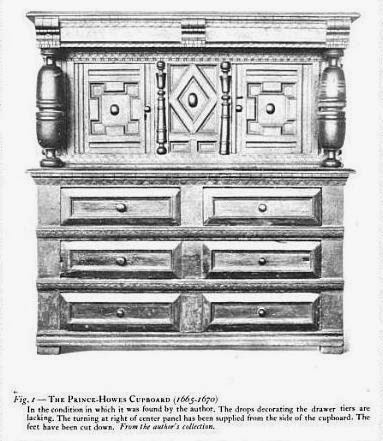How gorgeous is this piece?! I always get such a thrill when I see things in person that belonged to my ancestors and this one did not disappoint!
It belonged to Mary (Burr?) Howes (ca 1603 to December 1695) and her second husband Thomas Prence (ca 1600 to March 1673). It stayed in the family until 1925 when a descendant sold the cupboard for $3,000 to Wallace Nutting. Massachusetts native Wallace Nutting was a famous photographer, artist, and antiquarian. Wealthy banker J. Pierpont Morgan Jr. purchased the piece for a then astounding amount of $20,000 and donated it to the Atheneum.
Mary had married, first, Thomas Howes (ca 1590 to October 1665). They are my eighth great-grandparents. I descend from their son Joseph Howes who married Elizabeth Mayo. I wrote about Mary and Thomas Howes here and here.
Thanks to the cozy little world that was Plymouth Colony, I also descend from Gov. Thomas Prence through his daughter Mercy Prence from his first wife Patience Brewster. Mercy married Major John Freeman. Mary (?Burr) Howes was Thomas Prence's fourth wife. I wrote about Thomas Prence here.
 |
| Description of the piece at Wadsworth Atheneum |
The description at the museum reads:
Court Cupboard, 1665-1675
American, Yarmouth,
Massachusetts
Red cedar, red oak, white cedar and white pine
The Wallace Nutting Collection, Gift of J. Pierpont Morgan
1926.289
This cupboard, which belonged to Thomas Prence (c. 1600-1675),
a governor of Plymouth Colony, is among the masterpieces of seventeenth-century
furniture. Nutting bought the cupboard
from a descendant of Governor Prence in 1921 and felt it was the most important
object in his collection. Court cupboards were the most expensive furniture
form to produce in the seventeenth century and used in households to store
imported textiles and valuables. This monumental case is decorated with
mannerist style carving, molding, turning and paint and belongs to...related
chests with serrated moldings made by Plymouth...
Unfortunately I can’t read a few words
on the description because of glare. It irks me there is no mention of Mary!
There is an article about the Cupboard in the October 1922 issue of Antiques magazine, written by Wallace Nutting himself. It traces the path the cupboard took through family members. The article can be found through a googlebooks search.
From Thomas Prence's March 1673 will:
My will is that Mary, my beloved wife shall have such household goods of Any kind as were hers, before wee married, Returned to her againe.
Item I give unto my said loveing wife my best bed and the furniture there unto appertaining, and the Court Cubberd that stands in the new Parlour with the Cloth and Cushen that is on it.
I have read that Mary bought the cupboard with her when she married Thomas Prence in the 1660s, but the way the will is written seems to indicate it was not part of her dowry. Nutting wrote that the bed and cupboard were the most valuable and important pieces of Prence's personal property and giving them to Mary was a mark of respect and affection. Prence's generosity was unusual for that time period, which makes me think Mary was a very special person whom he appreciated at a time when women had so few rights.
Mary returned to Dennis, Mass., after the 1673 death of her husband, bringing the Court Cupboard with her. It stayed in the family until 1921 when Wallace Nutting purchased the piece for $3,000.
Mary died in December1695; she was about 92 years of age. The inventory of her estate mentions an old chest and cupboard at Prence Howes' (her grandson--a Howes and Prence descendant). The Howes Family Association purchased a chest/trunk that belonged to the Howes family which is on display at the Josiah Dennis Manse in Dennis. Another place for me to visit!
 |
| Sketch of cupboard before restoration from Nutting article |
 | |
| Sketch of cupboard after restoration from Nutting article |
